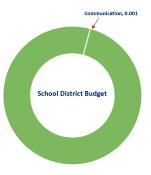Get Aggressive in Building Your Communication Budgets

Pulling for Your PR Budget
In an era of public-education bashing coupled with increasing competition for students, school leaders must integrate communication into all that we do or we will risk losing the battle we now face. A strong communication function will help you advance your system during this period of uncertainty.
But you can do only a little bit — and in inconsistent ways — if you do not have the resources you need to make a difference. Yes, money does make a difference.
Here is a case in point:
NSPRA members tell us that most NSPRA districts spend just one tenth of one percent of their entire school district budget on communication.
One tenth of one percent — that’s .001%! Really?
Non-NSPRA member districts most likely spend less than that.
Our assessment is that corporate charter companies are spending from 10 to 25% or more of their budgets on their communication and marketing efforts.
In comparison, this is not a fair fight!
Think about it. A district with a total budget of $100 million sets aside just $100,000 to cover a full-time experienced professional and possibly a part-time assistant. That leaves little or nothing in the budget for tech tools of mass communication and engagement services, video capabilities, software for efficiency, tech equipment, professional development, and more. Although talented NSPRA professionals are known for stretching the impact of their dollars, there are only so many times that they can consistently pull rabbits out of their respective hats if they don’t have the money to back up their herculean efforts.
Former Vice President Joe Biden often says he can tell an organization’s priorities very quickly by looking at their line-item budgets. And this sentiment is painfully obvious to us as we look at the dilemma that school communication professionals face today. It may be time for your leaders to look at your budget and consider what your district needs.
Most school districts are now in the midst of building their operational budgets for the year ahead. So, now’s the time to get aggressive in making sure that your system has what it needs to be competitive in the school choice movement.
To get started on persuading leaders to increase communication budgets consider these two approaches:
Use a Cold-Cash Accountability Model
For years, NSPRA has asked decisionmakers to look at enrollment swings in this era of choice. The more students you lose to competition, the more money you lose from state reimbursement.
With a well-planned marketing communication effort, you can retain students and recruit new students, which can make a long-term impact on your budget realities. For example, if you recruit 15 first graders who earn a $4-6K state reimbursement in just 1 year, you will have added $60-90K to your district’s budget for that year. If you retain them for all 12 years, your district would earn between $720K-1.08M over their school career. And that’s for just 15 students.
Investing in an accountable communication and marketing effort can reap large financial dividends for your system. But the investment must happen now to develop a marketing and engagement effort to retain and recruit students.
Budget for Schools that Are Most Vulnerable to Lose Students to Competition
Another accountable approach to communication budgeting is to select a few schools who may need extra communication assistance to help them build their brand in a competitive marketplace. View competition today as more of a school vs. school model rather than pitting your entire school district against one competing charter school. Parents are judging one school against another. In other words, think about how your Valley Elementary stacks up against the new ABC Elementary Charter just three blocks away. Changing your view of school choice will help you build your case for increased funding for your marketing efforts.
Each school needs to look at itself, assess it strengths and weaknesses, and then work on becoming your community’s school of choice. Communication and engagement efforts are key to this phase. Then your branding and recruiting efforts can effectively occur. You need to budget for the communication and engagement facet of the plan or you are surely bound to fall short in view of the competition.
By setting aside funds for this initial type of effort, you will help more budget decisionmakers understand where your communication dollars go. And you will assist in retaining and recruiting students, adding positive numbers to your district’s bottom line.
We need more effective communication to combat new education alternatives in our local communities. It is time to get aggressive in building a budget to meet these new communication needs in our schools. To make and market your schools as schools of choice in the year ahead, you need additional resources.
If we don’t do it, who will?
Remember, don’t create a communication vacuum because your competition will gladly fill it if they haven’t done it already.

Rich Bagin, APR
NSPRA Executive Director
Photo by Jim Cummings, APR, Glendale Elementary School District
Explore posts in the same categories: Budgets, Communication, school choice, school PR
Leave a comment